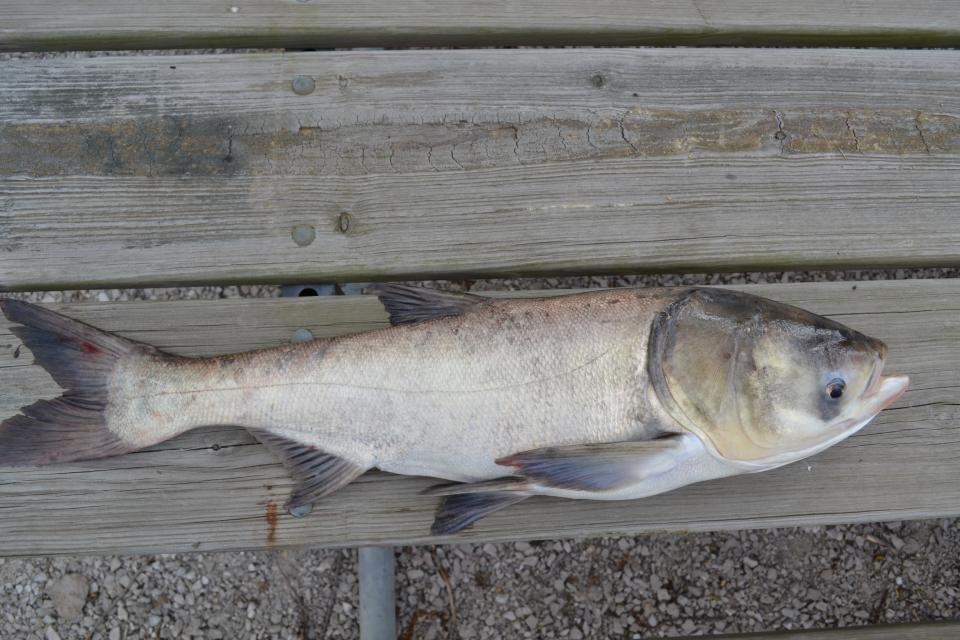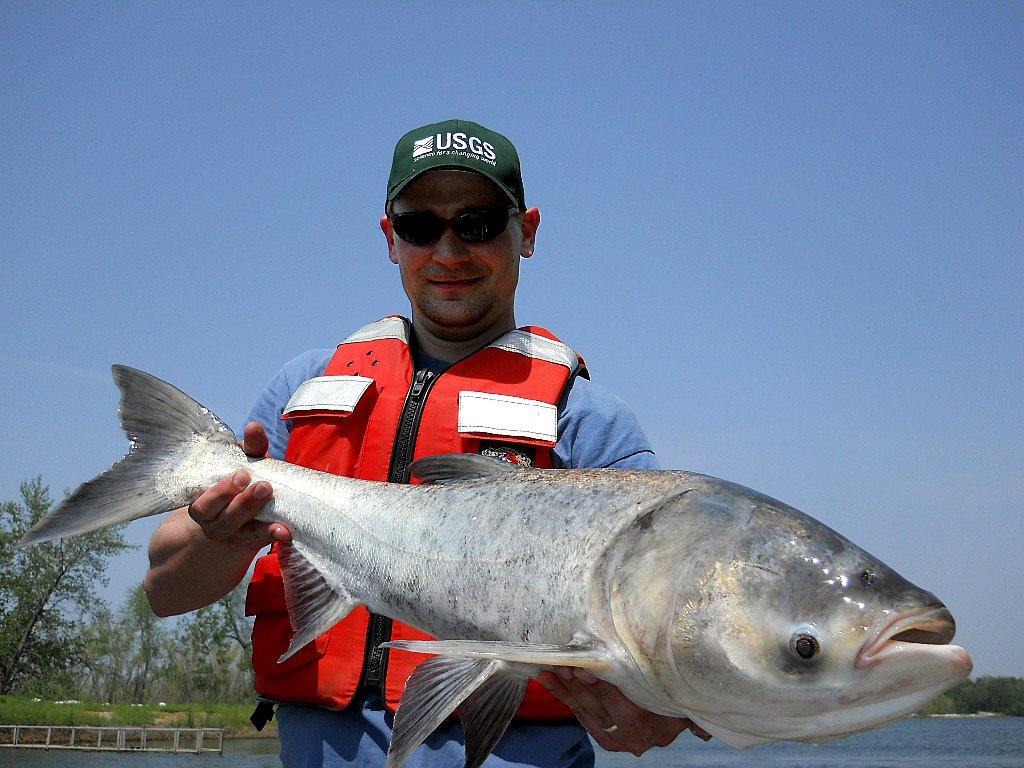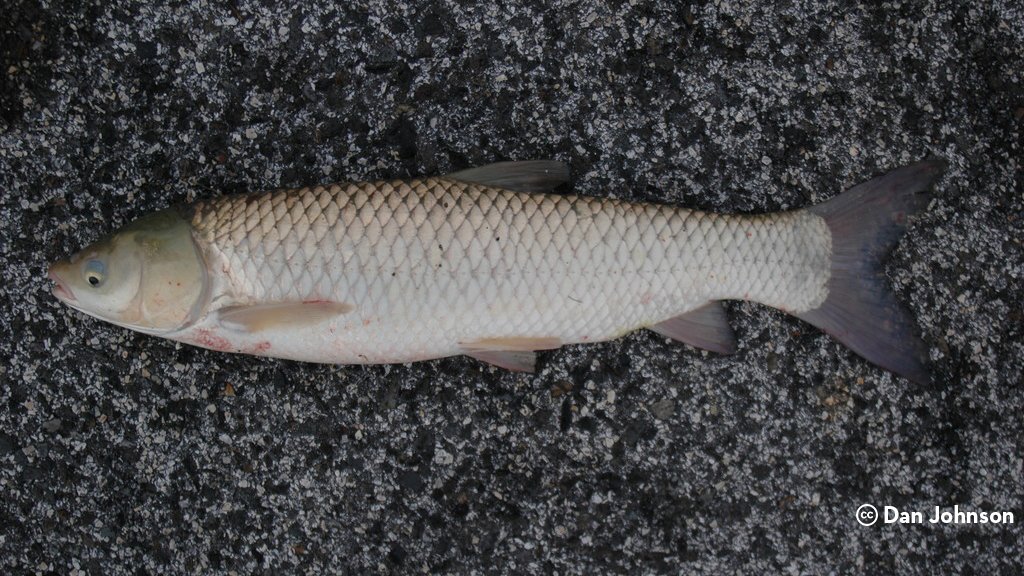Hypophthalmichthys molitrix (silver carp),Hypophthalmichthys nobilis (bighead carp) and Ctenopharyngodon idella (grass carp)
Silver, bighead, and grass carps are all invasive fishes referred to as "invasive carp." They threaten to become established in Minnesota, where ~30 silver and bighead carp combined have been caught between 1996 and 2018. Invasive carp pose threats to aquatic vegetation, food webs, commercial and recreational fishing, and silver carp pose additional threats to human health due to their propensity to leap out of the water when disturbed. More about invasive carp.
MAISRC Findings
- Discovered that they could be strongly deterred from passing through Mississippi River locks and dams by adjusting spillway gates due to their relatively weak peak swimming abilities
- Determined that a sweeping sound played in locks, when combined with an air curtain, should stop 99% of invasive carps from passing through while minimizing effects on native fishes
- Identified two novel viruses that have potential for biocontrol: picornavirus and paramyxovirus
- Created a numeric fish passage model that can inform the U.S. Army Corps of Engineers on ways to adjust spillway gates to stop carp while having minimal effects on native fishes
- Discovered that invasive carp use a unique set of sensory systems with novel sensitivities to food odors that can be targeted to attract them and stimulate them to consume poisoned food
- Identified a novel species-specific sex pheromone for silver carp that could be used to attract them
- Demonstrated that juvenile silver and bighead carps shoal (aggregate) in the laboratory, meaning that the Judas fish concept has potential to be used to locate and control these species
Research
Increasing effectiveness of bigheaded carp deterrents by carbon dioxide integration
The project looks to enhance and/or develop new barriers using carbon dioxide to deter the range expansion of invasive bigheaded carp.
Led by Dr. Allen Mensinger
A novel technology for eDNA collection and concentration
Researchers developed an eDNA filter that can screen quickly and cost-efficiently for native, invasive, and endangered species.
Led by Dr. Abbas Abdennour
Updating an invasive fish and native fish passage model for locks and dams
This project collected and updated field data that can used to better help stop invasive carp while allowing native fish to pass through Mississippi River locks and dams.
Led by Dr. Anvar Gilmanov
Attracting carp so their presence can be accurately assessed
This project developed ways of using both food and sex pheromones to attract and measure the presence and density of carp using the environmental DNA (eDNA) they release to the water.
Led by Dr. Peter Sorensen
Blocking bighead, silver, and other invasive carp by optimizing lock and dams
This project worked to prevent the upstream spread movement of invasive carp by developing a scheme to modify lock and dam structures in Minnesota by enhancing their deterrent properties.
Led by Dr. Peter Sorensen
About invasive carp
Description
All carps in the genus Hypophthalmichthys can be characterized by a stout body with a large head, downward-facing eyes, small scales, and a jaw without teeth. Two defining features of the genus are gill rakers and epibranchial organs, which sense chemical food cues and may control reflexive filter feeding behavior in bighead carp. It has been established that filter function is a passive and mechanical morphological function, meaning that chemosensory perception is important for these fish to feed – as opposed to vision – opening up a potential opportunity for control. In addition to their unique epibranchial organs, carp also have an above-average sensitivity to sound. They detect sound with much greater sensitivity than most native fish – another life history weakness that may be targeted for control.
Bighead carp can be up to 1.3 meters (51 inches) in length, weigh up to 110 pounds (50kg), and live at least 9 years. They are silver in color with dark blotches along the dorsal region, and have no scales on their heads.
Silver carp can be up to 1 meter (39 inches) in length, weigh up to 77 pounds, and live up to 20 years. They are also silver with no scales on their head, and with a downward slanting mouth.
Grass carp can be up to 1.5 meters (59 inches) in length, weigh up to 99 pounds, and can live up to 21 years. They are olive green in color with a rounded snout and an over-hanging upper lip.
Life cycle
Bighead carp (Hypophthalmichthys nobilis) mature at 2-7 years old. Adults spawn in rivers, and their eggs drift into low-flow nursery areas. Each female can produce up to one million eggs per year. Both juveniles and adults eat zooplankton, the basis of the food chain.
Silver carp (Hypophthalmichthys molitrix) mature at 2-6 years old and have similar spawning habits to bighead carp. Females can produce up to two million eggs per year. Juveniles eat zooplankton and phytoplankton; adults just eat phytoplankton.
Grass carp (Ctenopharyngodon idella) mature at 4-7 years old, with females producing up to two million eggs per year. Juveniles prey on aquatic invertebrates; adults eat aquatic and terrestrial plants.
Impacts
Grass carp are voracious feeders that pose a threat to terrestrial plants, such as shrubs at the water line. Grass carp can also eradicate aquatic vegetation that serves as a food supply for waterfowl and as refuge from predators for young fishes (Bain 1993). Even in areas where they have become established – the Chicago canal system, for example – grass carp do not appear to become a dominant component of fish biomass. Grass carp were originally introduced to the United States in 1963 as a method for pond and lake maintenance (Mitchell and Kelly 2006) and are still stocked and sold in some states. Due to concerns about its invasiveness, grass carp are commonly produced as triploid, or sterile, fish. Illegal sale and transport of diploid fish can still result in unwanted fertile populations. The ecological risk associated with grass carp has been uncertain, however recent observations of wild grass carp in the Great Lakes basin have caused some environmental managers to call for the re-evaluation of the ecological risk and regulatory structure concerning this species (e.g., Conover et al. 2007).
Silver and bighead carps are filter-feeders, straining microscopic plants and animals out of the water and away from paddlefish, gizzard shad, and young gamefish which rely on them. This disruption affects native fish and waterfowl and could result in diminished recreational and commercial fishing opportunities in the region. Silver carp also pose a threat to human health due to their propensity to leap out of the water when disturbed by watercraft. Bighead and silver carp were imported to the U.S. in the 1970s and escaped from captivity shortly thereafter. Silver and bighead carps have become highly invasive in rivers such as the Mississippi and Illinois Rivers, where they can comprise up to 75% of the fish biomass (Kolar et al. 2005). Bighead and silver carp are considered a threat to native aquatic biodiversity and ecosystem health because of their wide environmental tolerances, large size, high fecundity, and voracious filter-feeding eating habits. Additionally, silver carp, with their tendency to jump up to 3 meters out of the water when disturbed (Kolar et al. 2005) can threaten human safety, recreation, and water-based economies.
The closest reproducing population of silver and bighead carps to date is thought to be in Iowa, and both species now threaten to become established in Minnesota, where approximately 30 silver and bighead carp combined have been caught between 1996 and the end of 2015. The location and abundance of bighead and silver carp in Minnesota has proven difficult to determine. Weaknesses that may be targeted for detection, prevention, and control include: a tendency for these fish to aggregate and shoal (Sorensen and Ghosal); their unique olfactory and eating habits; their swimming capabilities; and their exceptionally good sense of hearing as compared to many other native fish.
Distribution
Populations of bighead and silver carps are established in the Mississippi River and its tributaries downstream of pool 16, near Davenport, Iowa. In Minnesota, individual invasive carps have been caught, but there is no evidence to date that they are reproducing in Minnesota waters.
- Fifteen individual bighead carp have been caught in the St. Croix River since 1996, with five caught in June of 2015 near Stillwater – the furthest upstream the invasive fish have been detected and the largest number caught in the St. Croix to date.
- Ten silver carp have been caught in the Mississippi River in Minnesota since 2008, as far upriver as Pool 2, near Cottage Grove, in 2014.
- Numerous individual grass carp have been caught in Minnesota, including in the Mississippi River and the St. Croix River. Many are thought to be escapees from stocking operations in Iowa, which allows for the sale of sterile grass carp, however a diploid (sterile) grass carp was caught in the Minnesota River in December of 2015. The invasion front for grass carp is currently thought to be the Great Lakes, where grass carp populations have recently been found and are expected to expand (Kocovsky et al. 2012; Chapman et al. 2013; Cuddington et al. 2014).
How they spread
Grass carp were introduced to the U.S. in the early 1960s and subsequent intentional and accidental releases have led to their becoming established in many states (Guillory and Gassaway 1978; Hargrave and Gido 2004).
Bighead and silver carps were imported to the southern U.S. in the 1970s to remove algae and other suspended matter out of catfish farm ponds and wastewater treatment plants. They escaped into local waterways shortly afterwards following severe flooding in which farm ponds overflowed their banks. Since then, they have been traveling steadily upstream, spreading to major river systems, including the Mississippi River, toward Minnesota.
Bighead carp thrive in degraded and channelized river environments, making the Chicago River and the Mississippi River ideal pathways of spread. Researchers at the MAISRC believe an impediment to the northward invasion of bighead and silver carps is the lock and dam system maintained by the US Army Corp of Engineers, which could be optimized to block their spread.



